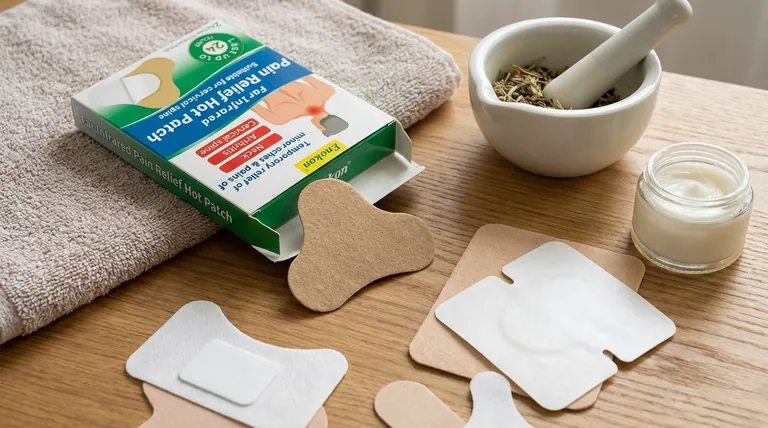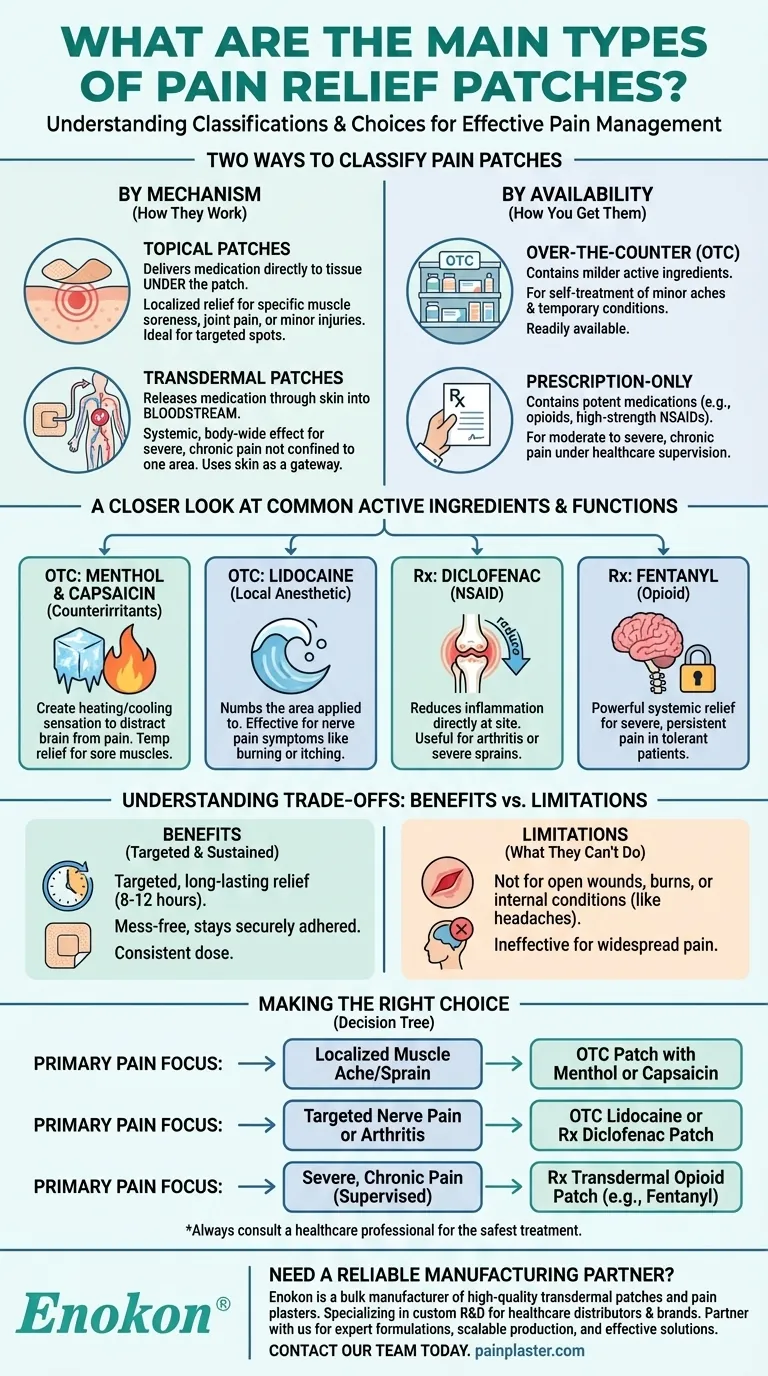At their core, pain relief patches fall into two primary categories based on how they work and how you get them. They are classified either by their mechanism of action—topical versus transdermal—or by their availability as over-the-counter (OTC) versus prescription-only medications. Topical patches treat localized pain on the surface, while transdermal patches deliver medicine through the skin into the bloodstream for systemic effects.
The crucial difference lies in the goal: topical patches provide targeted relief for a specific area, while transdermal patches use the skin as a gateway to deliver powerful medication throughout your body for more severe, chronic pain.

Two Ways to Classify Pain Patches
To choose the right patch, you must first understand the fundamental differences in how they are designed to function and the type of pain they are intended to treat.
By Mechanism: Topical vs. Transdermal
A topical patch works by delivering medication directly to the tissue under the patch. Its effects are localized, making it ideal for muscle soreness, joint pain, or minor injuries in a specific spot.
A transdermal patch, on the other hand, is designed to release medication that is absorbed through the skin and into the bloodstream. This creates a systemic, body-wide effect, which is necessary for managing severe or chronic pain that isn't confined to one area.
By Availability: OTC vs. Prescription
Over-the-counter (OTC) patches contain milder active ingredients and are intended for minor aches and pains. They are readily available at pharmacies for self-treatment of conditions like muscle strain or temporary joint discomfort.
Prescription patches contain potent medications, such as opioids or high-strength NSAIDs. These are reserved for moderate to severe pain conditions like chronic neuropathy or cancer pain and must be used under the strict supervision of a healthcare provider.
A Closer Look at Common Active Ingredients
The active ingredient in a patch determines its specific use and strength. Understanding these ingredients helps clarify the distinction between OTC and prescription options.
Over-the-Counter (OTC) Options
Lidocaine is a local anesthetic. Patches containing lidocaine numb the area they are applied to, making them effective for nerve pain symptoms like burning or itching.
Menthol and Capsaicin are known as counterirritants. They create a heating or cooling sensation that distracts your brain from the underlying pain signal, providing temporary relief for sore muscles and minor aches.
Prescription-Strength Solutions
Diclofenac is a nonsteroidal anti-inflammatory drug (NSAID). A diclofenac patch reduces inflammation directly at the site of pain, making it useful for conditions like arthritis or severe sprains.
Fentanyl is a powerful opioid analgesic. Transdermal fentanyl patches are used only for the management of severe, persistent pain in patients who are already tolerant to opioids, as the medication provides potent, systemic relief.
Understanding the Trade-offs
While patches offer unique benefits, they are not a universal solution for all types of pain. It's important to recognize their advantages and limitations.
The Benefits: Targeted and Sustained Relief
The primary advantage of a pain patch is its ability to provide targeted, long-lasting relief. A single patch can deliver medication slowly over 8 to 12 hours.
This method is also mess-free and ensures the patch stays securely adhered to treatment areas like the back, shoulders, or legs, delivering a consistent dose.
The Limitations: What Patches Can't Do
Pain patches should never be applied to open wounds, severely burned skin, or areas with significant inflammation. Their action is localized and they are ineffective for internal conditions like headaches.
For widespread pain, other treatments like oral medications (NSAIDs or opioids) or physical therapy may be more appropriate alternatives, as they address pain systemically or correct underlying physical issues.
Making the Right Choice for Your Pain
Selecting the appropriate patch depends entirely on the nature and severity of your pain.
- If your primary focus is a localized muscle ache or minor sprain: An OTC patch with menthol or capsaicin is designed for this kind of surface-level relief.
- If your primary focus is targeted nerve pain or arthritis: An OTC lidocaine patch or a prescription NSAID patch like diclofenac may be the most suitable choice.
- If your primary focus is severe, chronic pain under a doctor's supervision: A transdermal prescription patch containing an opioid like fentanyl is intended for this level of pain management.
Always consult a healthcare professional to ensure you are choosing the safest and most effective treatment for your specific condition.
Summary Table:
| Classification | Key Function | Common Examples | Ideal For |
|---|---|---|---|
| Topical Patch | Localized relief on the skin's surface | Menthol, Capsaicin, Lidocaine | Muscle aches, joint pain, minor injuries |
| Transdermal Patch | Systemic relief via bloodstream | Fentanyl, Diclofenac | Severe, chronic pain requiring potent medication |
| OTC Patch | Self-treatment for minor pain | Lidocaine, Menthol | Temporary soreness, mild arthritis |
| Prescription Patch | Managed treatment for severe pain | Fentanyl, Diclofenac | Chronic conditions under medical supervision |
Need a reliable manufacturing partner for your pain relief patches?
At Enokon, we are a bulk manufacturer of high-quality transdermal patches and pain plasters. We specialize in custom R&D and development for healthcare distributors and pharmaceutical brands.
Partner with us to:
- Access expert technical support for custom formulations.
- Ensure consistent, high-quality production at scale.
- Bring effective, reliable pain management solutions to market.
Contact our team today to discuss your project requirements and benefit from our technical expertise.
Visual Guide

Related Products
- Far Infrared Deep Heat Relief Patches Medicated Pain Relief Patches
- Capsaicin Chili Medicated Pain Relief Patches
- Icy Hot Menthol Medicine Pain Relief Patch
- Menthol Gel Pain Relief Patch
- Far Infrared Heat Pain Relief Patches Transdermal Patches
People Also Ask
- How do pain relief patches compare to other pain relief methods? Discover Targeted, Long-Lasting Relief
- How should pain relief patches be applied and used? A Guide to Safe & Effective Targeted Relief
- How quickly does the Deep Heat Pain Relief Back Patch activate and how long does it provide warmth? Get 16-Hour Relief
- How do pain relief patches provide targeted relief? Discover the Science Behind Effective Pain Management
- How often should pain relief patches be used? Get the Right Schedule for Targeted Relief
















